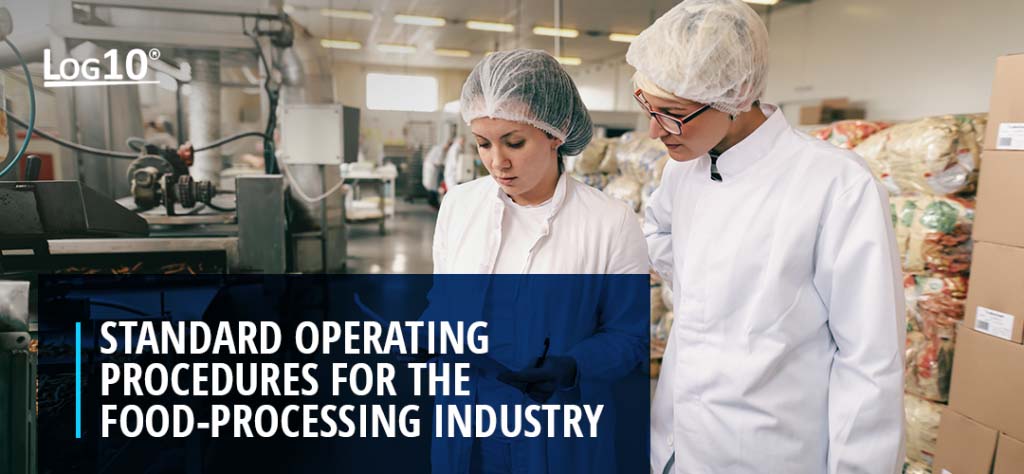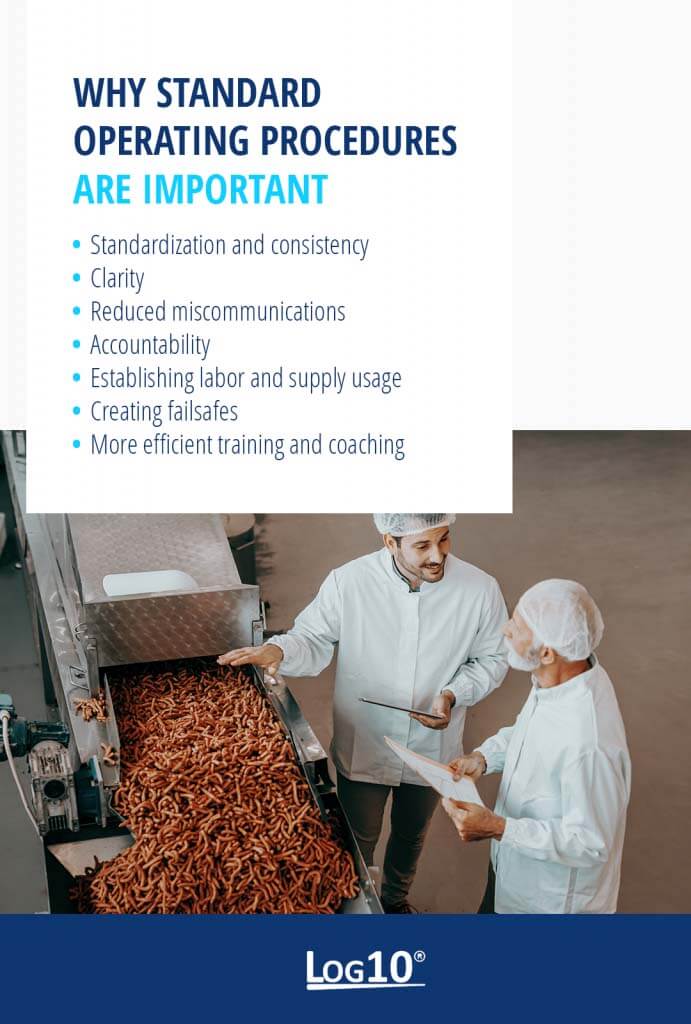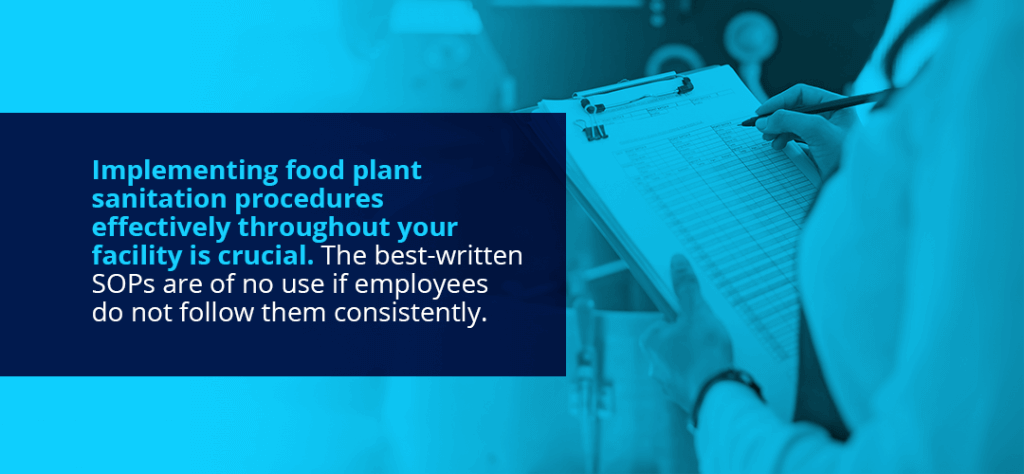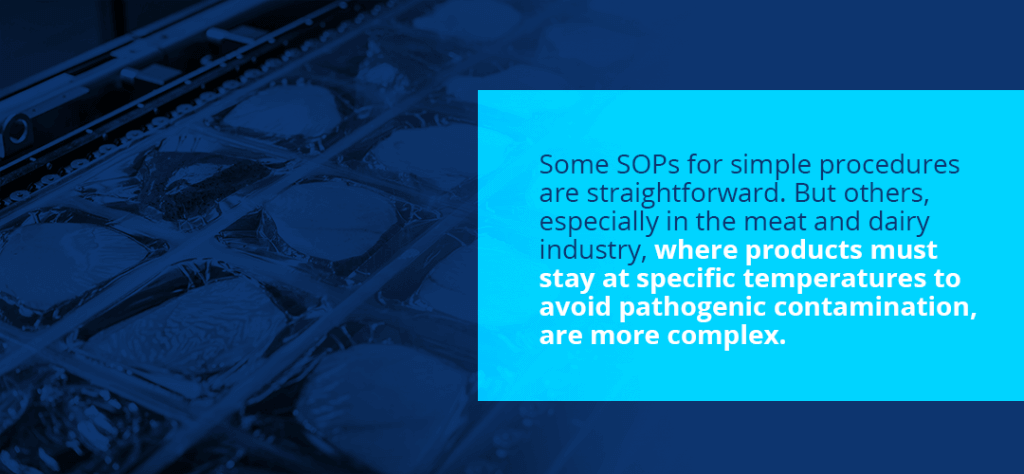
According to the Centers for Disease Control, one out of every six Americans becomes ill because of contaminated foods or beverages every year. And 3,000 of those people die. So, facilities must have protocols in place to ensure a working environment that is clean and sanitary and does not harbor or transmit contaminants.
Standard operating procedures, or SOPs, are crucial to the success of a facility’s production of safe, uncontaminated food. SOPs are written documentation and protocols for how your facility will handle and produce food safely. They document routine operations within the facility to ensure that employees perform those operations consistently and correctly.
Below, we will discuss some of the specific benefits of standard operating procedures for food processing and how to develop them properly to enhance your facility’s operations.
In This Article:
- Why Standard Operating Procedures Are Important
- How to Develop SOPs
- How to Make Sure SOPs are Followed
- Tracking and Understanding the Impact of SOPs
- Examples of Food-Processing SOPs
Why Standard Operating Procedures Are Important

SOPs are not just general guidelines. They should include specific details about how food safety standard operating procedures will be executed and what the discrete steps of the task will be. For these reasons, they provide the following benefits:
- Standardization and consistency: The step-by-step instructions of an SOP help create standardization and consistency within the operations of food production plants. When you have SOPs established, you will no longer run into situations where some employees perform a task in one way and some perform it in another way.
- Clarity: If some employees are not performing as they should, the reason may be that they don’t understand what is expected of them. An SOP helps provide clarity and gives employees the knowledge necessary to do their jobs as expected.
- Reduced miscommunications: Having SOPs reduces miscommunications within your facility because everything is written down. If a trainer or manager misspeaks, or if employees don’t remember everything a manager said, employees can reference the SOP, where all the correct details are written down.
- Accountability: An SOP creates accountability within a facility or department because it lays out clear, documented steps and expectations. Employees will know exactly what is expected of them, how to do it and the timeframe in which it needs to happen.
- Establishing labor and supply usage: An SOP helps a workplace establish the labor and material requirements needed to accomplish routine tasks.
- Creating failsafes: If an SOP includes a checklist that employees must initial, the checklist can serve as a way to double-check that all necessary tasks have been completed.
- More efficient training and coaching: If written protocols exist, they can be useful in training new employees. They help make sure no essential information is left out of training and ensure that new and old employees receive the same, noncontradictory information.
How to Develop SOPs
Before you jump into creating SOPs, spend a little time thinking about where SOPs will be most beneficial in your facility. Have you noticed employees neglecting to wash their hands or clean their workstations thoroughly? Have you noticed improper food storage methods, or have you seen chemicals being mislabeled or not labeled at all? Are there areas of your operation that you consistently find yourself being asked about, or talking to employees about? Figure out which aspects of your facility’s work would benefit from written protocols, and go from there.
When it comes time to create the SOP, you can follow these steps:
- Draft the SOP: When you’re drafting an SOP, it’s helpful to write down the steps of procedures as you perform them throughout the day. This method keeps the steps fresh in your memory. You can also find examples through a trusted and authoritative source online, such as the USDA website or a state agency website, or consult the FDA’s sanitation standard operating procedures. Then modify these to suit your purposes.
- Have experts look it over: If possible, engage with an outside consultant from a professional consulting service. Such consultants will have a wealth of subject matter expertise and be able to pinpoint areas for improvement or crucial details you may have missed.
- Walkthrough the SOP: Perform the operations as outlined in the SOP and see if they make sense. Make sure the instructions do not contain redundancies, and also make sure you have not left out any critical steps.
- Create an updated draft: You should incorporate any changes you have made as a result of walking through the protocol into the final draft.
- Perform a final walkthrough: Have someone else, such as a training supervisor, walk through the SOP process one more time to make sure it is easy to follow. This person can also point out any areas in which trainees or new employees are likely to make mistakes because the instructions in the SOP are not clear. After the final walkthrough, create a final draft, if necessary.
- Get approval: When the SOP is in its final form, get approval through the correct company channels.
- Post the approved SOP: Post the final SOP it where employees can easily read it during their work. You can also create a physical binder full of SOPs, or create an online resource where employees can access SOPs easily.
Basic cleaning SOPs like handwashing SOPs can be relatively straightforward. For these SOPs, a list of the steps involved in the protocol should be sufficient. For sanitation protocol, though, the SOPs —commonly known as sanitation standard operating procedures or SSOPs — should be a bit more detailed. A typical sanitation SOP contains the following elements:
- Name: Include the name of the person who wrote the SOP.
- Approval: Include the name of the person who approved the SOP.
- Date: Include the date the SOP was written.
- Purpose: State the reason the SOP is in place. SOPs do not have to include this element, but it can be beneficial.
- Name of responsible party: Indicate who is responsible for carrying out the SOP. This responsible party can be a specific person, or it can be the entire food-processing team.
- Frequency: This element should indicate how often — daily, weekly, etc. — the SOP will be carried out.
- Detailed procedures: This element should include instructions and a list of the steps to be performed.
- Record: Describe how SOP actions will be documented.
- Correction: Describe how failures of the SOP can be corrected. For example, if a cleaned food-contact surface still contains food residues, it should be cleaned again.
How to Make Sure SOPs are Followed

Implementing food plant sanitation procedures effectively throughout your facility is crucial. The best-written SOPs are of no use if employees do not follow them consistently. Taking the following steps can help ensure SOPs are followed.
- Hold a training meeting: One step you can take is to hold a training session on the new SOPs. At the training, you can roll out the SOPs and make sure all employees know what they need to do to follow the SOPs correctly. Emphasize that following SOPs is not optional. Have written copies of the new SOPs available for employees to look over and take with them for further review.
- Hold short refresher meetings: Periodically, hold refreshers on the SOPs. This step is particularly important when you have recently introduced new SOPs. Holding short refresher meetings can also help bring new employees up to speed and keep long-term employees informed of new developments.
- Create checklists: Creating checklists that employees must initial enforces a sense of accountability among employees by asking them to demonstrate that they have completed all required tasks.
- Include reasoning: Employees are more likely to follow SOPs if they understand the reasons for the protocols. Telling employees the sequence of detailed steps they must follow without explaining why they must follow them is likely to lead to confusion and corner-cutting. But explaining why the steps are critical can help employees feel more invested in the procedures. Ideally, each SOP would include a description of the policy that explains why the SOP is important.
- Perform an annual review: At least once a year, review your SOPs and make any necessary updates. Code changes, new equipment and reports of new disease outbreaks can all be cause for changing your SOPs. Also, evaluate how well your SOPs are working and how you could streamline them, make them more effective and increase employee compliance.
- Use concise, clear language: SOPs should be written in a style that anyone with a basic knowledge of the industry would find easy to read. Using verbose, over-technical language, excessive detail or complicated constructions is likely to lead to decreased compliance.
Tracking and Understanding the Impact of SOPs
It’s essential to track and review your SOPs to make sure they are working effectively and to understand how they have improved your operations:
- Ask for feedback: Ask employees how the SOPs are working and request feedback from direct managers on whether the SOPs are having positive effects on employees’ work.
- Set target goals: Set concrete, clearly defined goals for how you expect your SOPs to change your operation.
- Read logs: Many SOPs require employees to document the actions they took or to record their observations. Monitoring these logs will tell you if employees are taking the SOPs seriously and performing the required steps.
- Create a review period: Create a reviewing period for your SOPs in which you assess their efficacy. Observe whether the SOPs are working and take notes on what could be made more effective.
- Revise procedures: After verifying the efficacy of new SOPs during your review period, you can improve them by making revisions based on your observations of how the protocols work in practice.
- Think of your SOP as a living document: Your SOPs don’t have to be set in stone. You can periodically revise them to incorporate new ideas and techniques. Continuing to improve your SOPs based on new information helps ensure that your facility keeps up in the industry.
Examples of Food-Processing SOPs

Some SOPs for simple procedures are straightforward. But others, especially in the meat and dairy industry, where products must stay at specific temperatures to avoid pathogenic contamination, are more complex.
A sample handwashing SOP might read as follows:
Policy: All food-processing employees must wash their hands to prevent the spread of bacteria and foodborne illnesses to the public.
Procedures: All food-processing employees should wash their hands before and after handling food products using the following methods:
- Scrub hands and forearms with hot, soapy water for at least 20 seconds.
- Rub hands together.
- Scrub forearms.
- Wash between fingers.
- Rotate fingernails in the palm of the other hand.
- Rinse hands and forearms thoroughly in hot water.
- Dry hands with a paper towel.
- Turn off faucet and open door using a paper towel to avoid getting bacteria on clean hands.
A sample cleaning and sanitizing protocol for food-production surfaces might look something like this:
Policy: All food-processing employees must ensure that food contact surfaces are properly cleaned and sanitized after use. This policy is in place to prevent the spread of foodborne illnesses to the public.
Procedures: All food-processing employees should clean and sanitize food-contact surfaces after each use, or any time contamination by food occurs, by using the following methods:
- Remove all large food particles and packaging from the food-contact surface before cleaning.
- Scrape small food particles and residue off the food contact surface.
- Spray the food-contact surface with hot water.
- Prepare the necessary chemical solution. (See SOP XXX for instructions on chemical solution preparation.)
- Apply the chemical solution and scrub the food-contact surface thoroughly.
- Let the solution sit undisturbed for at least 10 minutes.
- Rinse the chemical solution off the food-contact surface with hot water.
- Check the food-contact surface to make sure no food particles or residues are visible. If particles or residues remain, repeat steps 3 through 7.
- Apply the sanitizing solution to the food-contact surface.
The meat and dairy industries have adopted the use of hazard analysis and critical control points (HACCP). A food-processing facility’s SOP’s are crucial to the success and the HACCP Program and the facility’s food safety plan.
The meat industry is likely to have SOPs related to keeping raw meat at the correct temperature to help slow the growth of bacteria such as Listeria monocytogenes. An SOP for the safe thawing of meat in a meat-processing facility might read as follows:
Policy: All food-processing employees must ensure that meat remains at a safe temperature to avoid pathogenic contamination and reduce the risk of transmitting foodborne diseases to the public.
Procedure: Employees must thaw meat at safe temperatures by following the steps below:
- Place frozen meat in a cooler or tempering room at 40 degrees Fahrenheit or lower. Allow the meat to thaw to the desired temperature. If the meat comes to a temperature above 41 degrees Fahrenheit, it must be cooled again to a temperature below 41 degrees Fahrenheit within eight hours of thawing to prevent contamination.
- Frozen meat may be thawed in a cooler or tempering room at <40 degrees Fahrenheit as long as the following precautions are followed: 1) Ground beef pieces of at least one pound are thawed for not more than nine hours, 2) whole chickens of at least 3.7 pounds are thawed for not more than nine hours, and 3) thawed meat is cooled to below 40 degrees Fahrenheit within two hours of thawing.
- Tempering and thawing conditions must be monitored closely to prevent the growth of pathogenic bacteria.
- Tempering and thawing meat must be monitored on a routine basis to prevent product drip that would contaminate other products.
- The surface temperature of the meat must be measured on a routine basis to ensure that it meets the temperature requirements above.
- The outer layer of trim or meat being thawed must be removed and refrigerated to prevent pathogen growth on the outer layer of the product. This process will be repeated as often as necessary to ensure uncontaminated products.
- If frozen meat is purchased from a third party, its lot code must be recorded in a product log before thawing occurs. This step ensures that the product can be tracked if the meat is recalled.
Contact Log10 for Help With Development and Review of SOPs
The development, review and implementation of SOPs is crucial to ensure a clean and sanitary food-processing environment and to avoid the transmission of foodborne pathogenic diseases to the public. When your facility is creating SOPs, make sure you have experts review your work to make sure your protocols are safe and effective and nothing gets overlooked.
Log10 can help. Our consulting services can assist your facility in complying with federal and state regulations and help you maintain a safe and sanitary environment. Contact us today.

